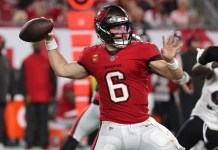With five weeks in the books in this NFL season, we’ve seen a rash of injuries that include some of the top players in the league. When working on power rankings and betting games, this can be the most important and trickiest variable to quantify. Look no further than Joe Burrow and his five-week journey. He has played each game but has looked nowhere near himself, making it very difficult on a weekly basis to be able to grade his health and performance. Last week was the healthiest and best we have seen Burrow move in the pocket, so he has to be upgraded to a point, but off his previous best effort, Week 3 vs the Rams, came arguably his worst performance vs. the Titans. Let’s dive into the value of injuries and how they affect line movements.
***Top NFL Resources***
*Join thousands of other sports bettors and unlock access to picks, public betting spits data, & the VSiN live video broadcast by upgrading to VSiN Pro. Grab your first month for less than $10.*
- NFL Expert Picks
- NFL Betting Hub
- NFL 2024 Week-By-Week Schedule
- Parlay Calculator
- NFL Betting Splits
- NFL Betting Odds
NFL Odds | NFL Betting Splits | NFL Matchups
Quarterbacks:
Nowhere better to start than with the most important position in football. There are two separate things that need to be focused on when looking at the value of a quarterback injury. Let’s look at Deshaun Watson as an example. At full health, I have Watson as a +3 grade, meaning he is 3 points better than the average NFL quarterback. His backup in Week 4, Dorian Thompson-Robinson, I have as a -3, meaning I have a 6-point adjustment when Watson is out and DTR is in. In that Week 3 matchup with the Browns and Ravens, the Browns were favored by -2.5 points before the Watson announcement and became a 2.5-point underdog with him out, a 5-point move. That adjustment was too low, but when you run into key numbers, it becomes difficult.
The move from -2.5 to +2.5 represents a 16% adjustment since both 1 and 2 lands approximately 4% of the time in an NFL game. Had the game gone to Ravens -3, that would add an additional 14% win share, since 3 is the most common number. At -2.5, the game was a profitable bet since the adjustment was not enough. At -3, the adjustment was very close to accurate. Even though the move would have been 5.5 points on a 6-point adjustment, the involvement of 3 makes a massive difference. Had the line moved to Ravens -3.5, a full 6-point move, there would have been close to a 30% adjustment.
When addressing a quarterback injury, it is important to look at the value of adjustment from the starter to the backup, but be aware of the numbers that the line crosses based on that adjustment. Not all numbers are created equal, and that adjustment can be lessened or expanded based on where the pre-injury line sits.
Non-quarterback adjustments:
Most people who are just starting to get involved in betting are shocked by the lack of value to a line by the majority of all non-quarterbacks. I have just two players at 2 points, Justin Jefferson and Travis Kelce, and every other player at 1.5 points or less. They both receive such high line value since the offense really falls off without their presence. Not only do you lose the counting stats, but you also do not have a legitimate secondary option. Their absence allows defenses to adjust coverage schemes and not have to roll double coverage or bracket coverage, making it more difficult for the ancillary pieces of the offense to get open.
Of the 100 players to whom I have set a value, just 22 of them are on the defensive side of the ball. Those 22 defensive players are dominated by pass rushers who have the greatest impact on a game and are the usual suspects (Bosa, Watt, Parsons, etc.). Pass rushers have the ability to change a game on every dropback with a sack or pressure that causes a turnover-worthy throw. There is no other position on the defense that can have such an impact.
I also have every “green-dot” defensive player as a -0.5 adjustment if they are out. The green dots are the only players who can communicate with the sidelines and are the play-callers on the defense.
Cluster injuries are the other major adjustment that I make from week to week. When you lose a single cornerback, there may be no adjustment made to the line, but when you lose a second cornerback and a safety, you are now missing three of the four starting pieces in the secondary. While no single player may be worthy of 0.5 points to the spread, the combination of the three could create as much as a 2-point move.
When you have cluster injuries at a position (generally this will be offense line, secondary or wide receiver), then you have to start taking into account things like communication and the time they are spent as a unit. For example, if an offensive line loses three starters, not only are the three backups in the game, but they are now playing with two linemen they do not generally practice with. Additionally, the expectation of those two linemen needs to be adjusted based on the capabilities of the backups. All that can equate to a large adjustment to the spread even though none of the three injured linemen alone would have affected the number.
There are wonderful resources available to track and understand injuries. Make sure to spend some time on Friday / Saturday before placing your bets to check on the players who are out and how much that should affect the line.




